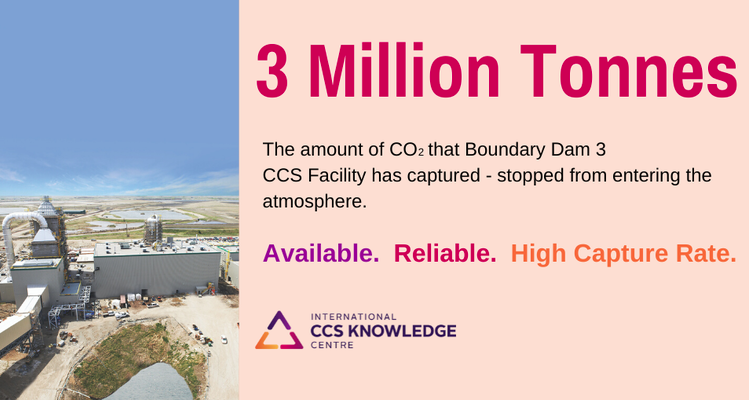World First in CCS Reaches 3Mt Milestone
Capture plant has also performed with successive improved reliability and a steady increase to the daily CO2 capture rate

SaskPower’s Boundary Dam 3 CCS Facility (BD3) recently surpassed three million tonnes (3Mt) of captured carbon dioxide (CO2). This demonstrates that as a first mover in carbon capture and storage (CCS) technology it continues to achieve, improve and make a steady impact in reducing and storing CO2 emissions.
BD3 has the honour of being a first in the world – which means that it has not only pioneered the implementation of the technology but the willingness to be on the forefront of learning and adaptation.? Within five years since its opening it has made the 3Mt milestone and the capture plant has also performed with successive improved reliability and a steady increase to the daily CO2 capture rate.
The International CCS Knowledge Centre (Knowledge Centre) is often sought after for its ability to share the substantial lessons learned in CCS. BD3 is a testament to learning comes from doing. The Knowledge Centre was designated by its founders, SaskPower and BHP, to share the rich expertise from BD3 with the world – due to CCS’s pivotal role to significantly mitigate greenhouse gas emissions (GHGs).
Setting a precedent in large-scale carbon capture, BD3 was the foundation for the Knowledge Centre’s second-generation CCS study, the Shand CCS Feasibility Study. This study revealed capital costs for the next plant to be 67% cheaper per tonne of CO2 captured and a capture rate able to reach up to 97% at reduced load while the plant is integrating with renewable electricity supplies. The Knowledge Centre is now extending these learnings to industry source emissions.
Indeed, the world continues to seek understanding and the practical application resulting from BD3’s learnings. Following a tour of the plant in May 2019, COP24 President, Michael Kurtyka told the media, “I am here because of the leadership role this country (Canada) and this region (Saskatchewan) is playing on the international scene. You are leaders in the world.? All that you bring to the table internationally is extremely important.”
Recognition
“We congratulate SaskPower’s Boundary Dam 3 CCS Facility on capturing 3 million tonnes of carbon dioxide since commencing operations in 2014. This significant milestone clearly demonstrates the viability of CCS technology in delivering clean sustainable energy from coal.? BD3 is showing the path forward for the integration of large-scale CCS technologies with power generation. The lessons learned from its experience are vital for the successful application of CCS technologies across the world and even beyond power generation into industrial sectors such as steel and cement.” – David Byers, Chief Executive Officer, CO2CRC
Quick Facts & Links
Large-scale CCS in Canada
Large-scale CCS has meant that over 43Mt on CO2 has been safely and permanently stored in Canada and therefore prevented from entering the atmosphere.
Large-scale CCS projects in Canada include:
- SaskPower’s BD3 CCS Facility
- Weyburn-Midale CO2 Monitoring & Storage Project
- Aquistore CO2 Storage Project
- Quest CCS Facility
- Alberta Carbon Trunk Line
Climate Change
- At no point in history were levels of CO2 concentrations as high or increasing as fast as it is now in modern day – Keeling Curve: A Daily Record of Atmospheric Carbon Dioxide (Scripps Institution of Oceanography, UC San Diego)
- CCS is considered essential in three of the four pathways to keep global warming within 1.5oC – Intergovernmental Panel on Climate Change: Global Warming of 1.5 Degrees Celsius
- Most of the world can’t meet emissions targets without CCS – and for those that can, the median increase in mitigation cost is 138% – Intergovernmental Panel on Climate Change: IPCC AR5 2014
CCS Links
- IEA GHG: What is CCS?
- 2nd Generation CCS – The Shand Study
- Learning By Doing – Cost Reduction Potential for CCUS at Coal-fired Power Plants
- Global CCS Institute: CCS Readiness Index
About the International CCS Knowledge Centre (Knowledge Centre)
Operating since 2016 under the direction of an independent board, Knowledge Centre was established by BHP and SaskPower with a mandate to advance the global understanding and deployment of large-scale CCS to reduce global GHG emissions. The Knowledge Centre provides the know-how to implement large-scale CCS projects as well as CCS optimization through the base learnings from both the fully-integrated Boundary Dam 3 CCS Facility and the comprehensive second-generation CCS study, known as the Shand Study.
Source: International CCS Knowledge Centre, press release, 2019-11-22.
